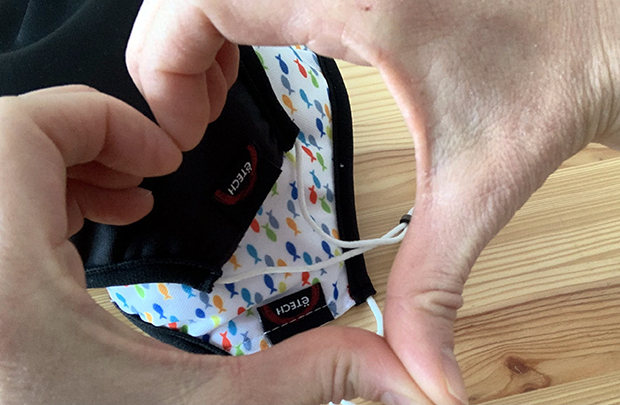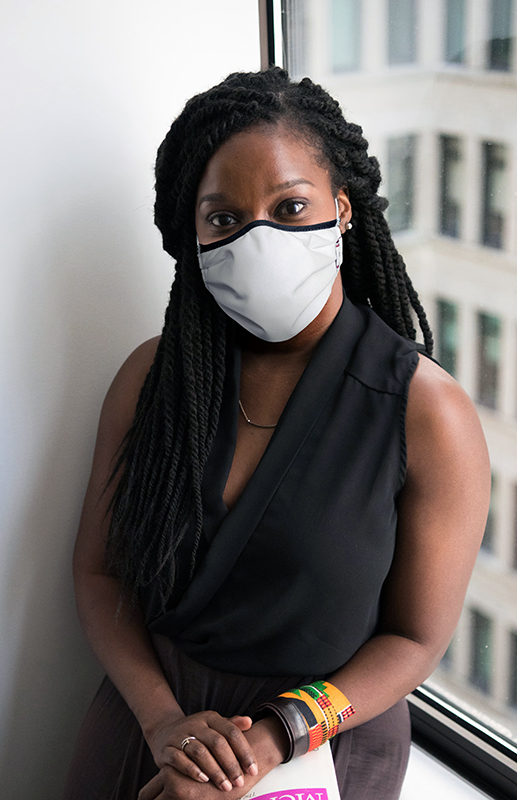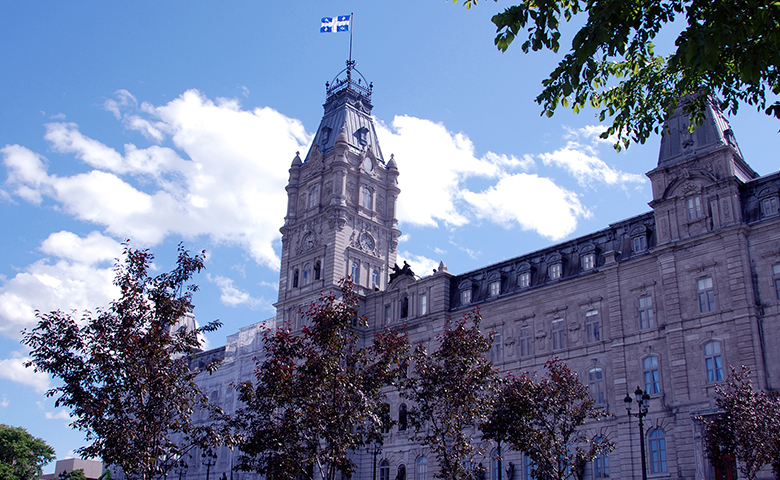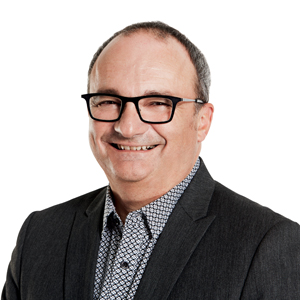A Gaspésie SME has developed a medical mask that can be washed a hundred times and retain its fine particle filtration capacity—an innovation that will open the doors to the global market.
Our team is very pleased to be supporting this innovative company during its development phases. We spoke with Frëtt Design and Frëtt Solutions founder, Michelle Secours, to shed some light on her success and her organization’s challenges.
Frëtt Solutions is the eco-efficient technical textile R&D division of Frëtt Design, a company that designs and manufactures ethical and eco-responsible clothing in Caplan, Gaspésie. The company recently received Health Canada medical device license approval for its reusable masks. This is a big step forward as the healthcare system is one of the largest users of disposable masks.
“Single-use masks are a real danger to the environment. They release millions of plastic microfibres that are not biodegradable. With the quantity of masks that are used and thrown away every day, we had to find a solution to avoid an ecological disaster,” says Michelle Secours.
From ethical clothing to an eco-responsible medical mask
Sensitive to the impact of textile production on the environment, Michelle Secours continues with Frëtt Solutions the eco-responsible mission of Frëtt Design, the company she founded in 1997. For 25 years, the SME has been using mostly natural and ecological materials such as hemp, merino wool or organic cottons in the manufacturing of its clothing for women, men and children.
The company responded to the health emergency at the beginning of the pandemic by starting to manufacture washable barrier masks for the general public. At the same time, a small core of employees dedicated themselves to the development of medical grade masks that could be reused by washing and disinfecting to meet a growing demand from the healthcare community.
“Each of our masks replaces 200 disposable masks. We have succeeded in achieving results that no one else has been able to match, both in performance and sustainability,” says the entrepreneur proudly.

Patented reusable medical mask
The learning curve was steep for her and her team. “We had to learn everything about the particle filtration capabilities of fabrics. We tested more than 130 combinations of multi-layered materials, so we knew what worked and what didn’t. Our goal was to create a washable mask that would meet the criteria of international standards for personal protective equipment in terms of breathability, efficiency and comfort.”
Her team worked for more than a year to develop the etrëma reusable multilayer surgical mask, which can be washed up to 100 times before being recycled.
The etrëma mask uses a textile filtering technology, called ëncore®, which is now patented in more than 60 countries. It meets the highest criteria of protection and product safety according to international standards for medical devices. Its development was the result of a collaboration between Frëtt Solutions and several experts from international research centres, laboratories and health institutions.
Conquering new markets
The company has met some of the challenges with panache and is continuing to build on its momentum.
License and certifications
Now that it has received Health Canada approval with the Medical Device Establishment License, as well as European certifications, Frëtt Solutions is ready to produce its etrëma masks on a large scale and begin marketing in clinical settings.
“However, it has taken a long time to get approval from the CNESST and Health Canada. In the latter case, the response came at the end of 2022, which now opens the doors to the healthcare sector,” specifies Michelle Secours.

New distribution channels
To do this, the company has to open up distribution channels that differ significantly from those it uses for its fashion products. In addition to its workshop-boutique in Caplan, the company sells its clothing online, in its Montréal boutique and at various events.
Its masks and other medical products in development are intended for the institutional sector, such as hospitals and other healthcare facilities.
“We also target professionals, such as dentists, medical clinics and anything related to close care, such as aesthetics,” says Michelle Secours.
Mask reprocessing procedure
In order to expand the use of this reusable mask, how it is used in healthcare settings must be reviewed, such as adopting a mask reprocessing procedure, which takes some time to implement.
Some hospitals are currently conducting pilot projects in Québec and elsewhere in Canada. Private clinics are also testing the mask.
While waiting to deploy across the entire health network, the company is working on other development projects based on its patented technology, including N95 masks and washable and reusable personal protective equipment (PPE).
Reinventing the business
Development of this innovation marks a new turning point for Frëtt Design. This is not the first time that the SME has innovated. In its early days, it built a solid reputation with industrial knitting techniques and upcycling principles that reused raw materials and enhanced their value.
“We sold our designs in over 100 stores worldwide, including major retailers like Bloomingdale’s and Saks Fifth Avenue in New York,” says Michelle Secours.
Then, as textile manufacturing shifted to Asian countries, it became increasingly difficult for Frëtt Design to continue producing locally. It was at this point that she reviewed her company’s mission.
The creation of the Frëtt Solutions division offers her organization new inspiring opportunities.
“We are proof that we can innovate even if we are not in a large urban center and do not have large R&D resources. Most importantly, we continue to do our part for the health of the environment.”
You could also like to read
Next article
On International Women’s Rights Day, let’s celebrate where we are and look at the ground we still have to cover to achieve equality.
While we have come a long way in terms of women’s contribution to our success, we haven’t yet reached our goal: gender equality in everything, everywhere, all the time.
That’s why Grant Thornton International’s Corporate Social Responsibility (CSR) team addressed this critical issue in Women in Business 2023: The push for parity, a highly insightful report released by our global network.
This report argues that if companies do not implement a culture of empowerment through flexible work arrangements, or take additional steps to support women’s access to leadership positions, by 2025 women will hold only 34% of those positions—a far cry from the UN’s goal of parity by 2030.
Fortunately, at Raymond Chabot Grant Thornton, we have a solid record of gender parity in management positions, 48% of which are held by women.
Daring to open the door and cross the threshold
Drawing on the experiences of inspiring women who have succeeded in becoming managers, such as Mireille Dallaire, Senior Manager – Business Systems, Information Technology at our firm, this report includes a list of the actions needed to change things for the benefit of future generations.
“We are fortunate to have been born in countries where many doors are open to us. We therefore have a duty to encourage our girls and boys to think critically about what is happening, here and in the world, in terms of rights disparities. We need to teach our girls to be bold, to say what they want and what they want to accomplish, like becoming a CEO, for example,” says Mireille.
DigitALL: Innovation and technology for gender equality
This year, the UN has chosen to mark International Women’s Day with the theme “DigitALL: Innovation and technology for gender equality”. We wanted to interview Mireille to understand what motivated her to enter an industry where women managers—and women overall—are underrepresented.
“When the opportunity arose to implement an ERP (enterprise resource planning) system, I didn’t really think about whether or not it was something I was capable of implementing. I thought, ‘I like systems so I’m going for it!’ My background in accounting, assurance and compliance could have hindered me as this new path presented a very big change in direction. But the most important thing is to be on the right path, and for me, that’s systems,” says Mireille.
Our 75th anniversary is a great opportunity to reflect on how far we have come within our firm, and in society, to close the rights-and-privileges gender gap. It also allows us to continue to make strides in CSR, including acting on the United Nations’ Sustainable Development Goal #5: Gender equality.
Next article
IAS 36 Impairment of Assets is not a new standard and, while many of its requirements are familiar, an impairment review of assets (either tangible or intangible) is frequently challenging to apply in practice. This is because IAS 36’s guidance is detailed, prescriptive and complex in some areas.
The Insights into IAS 36 series has been written to assist preparers of financial statements and those charged with the governance of reporting entities to understand the requirements set out in IAS 36 and revisit some areas where confusion has been seen in practice.
The final two publications in the Insights into IAS 36 series cover disclosure requirements when an entity recognizes an impairment loss and/or reversal during the reporting period and considerations for some regularly encountered issues when applying the standard:
- Presentation and disclosure;
- Other impairment issues.
The publications mentioned above follow this IFRS Adviser Alert.
Next article
Tourism is evolving and must contribute to local and regional citizens’ well-being. Here are the development avenues to promote.
Tourism is a rapidly changing industry. When its development is well planned, it offers great opportunities to contribute to citizens’ quality of life and regions’ economic vitality. To do this, it is essential that all the involved tourism and non-tourism stakeholders work together.
Municipalities must consult with citizens to implement appropriate regulations, infrastructures and guidelines that encourage people to live together in harmony while discovering a living environment. In the medium and long run, a tourism destination that neither consults with its residents, nor involves them in decision-making, dooms itself to impoverishment.
Changing needs
Ways of travelling are changing and authentic destinations are more popular than ever. Exploring a culture involves more than visiting a museum or park, or participating in an event. True, these activities are always safe bets. But today’s visitors want to follow the local drumbeat. They go to neighbourhood restaurants and bakeries, and sometimes become your next door neighbours.
What’s more, tourists are now benefiting from the flexibility afforded by telework. They are looking to reduce their travel impacts: they extend their stays, prefer active mobility and seek out local products.
With these emerging behaviours, it is necessary to adapt in a way that benefits local citizens. Specifically, a thriving tourism industry enables regions to provide high quality activities and infrastructures that would otherwise be unthinkable.
Focusing on the following actions will help apply solutions that benefit all parties.
Promote local culture to foster citizen pride
Tourists are looking for an enjoyable and unique experience. Regions need to be promoted and explained, and have their stories told. The visitor and the local culture must be drawn together to strengthen an area’s identity.
Important and historical sites—natural or urban—can be revitalized and developed to enable citizens to reclaim public spaces and revamp them in the community’s image. It is not only the residents’ quality of life that benefits: the signature experience that emerges from such initiatives also makes the destination more attractive to travelers.
Encourage mobility and sustainability
In this expanding context of mobility and telework, it is paramount to implement certain infrastructures, including a high-speed Internet offer.
To be attractive, destinations must play a leadership role in sustainable development, as proposed by the Québec government’s tourism department in its Plan d’action pour un tourisme responsable et durable (Action Plan for Responsible and Sustainable Tourism).
For example, working through their tourism office, municipalities need to make their tourism ecosystem aware of this issue, propose practical solutions and inform tourists of sustainable products and services.
Businesses must also implement sustainable development actions by putting forward eco-responsible practices and promoting local purchasing.
Promote the development of a balanced offer
In six years, Québec’s rental property offers have exploded by 200%. They include cottages, luxury residences, condos and even temporarily rented principal residences.
This new accommodation offer is changing the industry’s relationship with travellers, who can settle in relatively long term—including in regions and neighbourhoods that used to receive few, if any, tourists.
It is important to preserve a balance that ensures that citizens and visitors live together in harmony. In Québec, the Tourist Accommodation Act covers short-term tourist accommodation and allows municipalities to exercise greater control over their accommodation offer.
Highlight a region through local purchasing
The proliferation of tourist residences makes it easier for visitors to discover communities: it takes them off the beaten track and allows them to live like a local.
This type of temporary resident will mix more with local people by living like them, sharing their daily lives, buying from public markets, for example, as well as going to local cafés and bistros—all of which contributes to the vitality of a community at various times of the year.
Under certain conditions, as telework becomes the norm, stays could even keep stretching longer. Local infrastructures, regulations and business development must be adapted to factor in this new situation.
Enrich the cultural life of citizens and attract visitors
A year-round diversified tourism and cultural offering is a considerable asset for attracting citizens and tourists alike. Promoting the improvement of infrastructures and original events will enhance destinations’ quality of life and attractiveness.
By seeking first to offer a better quality of life, cities and regions ensure they are respecting their core values and are being authentic. That is exactly what attracts visitors and contributes to a community’s vitality.
This article was written in collaboration with Ingrid Langevin, Director of the Business Transformation Consulting Group at Raymond Chabot Grant Thornton.
23 Feb 2023 | Written by :
Denis Brisebois is a management consulting expert and leader in tourism, leisure and culture....
See the profile





